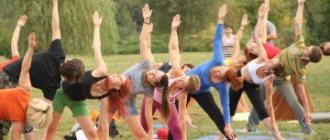Meet yoga
The Eastern physical-spiritual discipline is rapidly gaining popularity not only in its homeland, the movement is finding its fans all over the world. What is yoga? It is an ancient branch of philosophy that first originated in India. More than 5,000 years ago, monks began to practice a teaching that unites the inner and outer world of man. Yoga practitioners claim that it is the integration of body, mind and soul to achieve a happy, harmonious and healthy life. Ultimately, man must achieve the highest freedom.
It is not known for certain who created the knowledge system called “yoga”. There is no written information about who invented this movement. At the time when it began to be practiced, writing did not yet exist. Yogis have been passing on knowledge to their students by word of mouth for thousands of years. As the teaching spread, many different schools appeared. The first mentions appeared in works written by Patanjali (Indian sage). He lived about 2000–2500 years ago. Patanjali is credited with writing the Yoga Sutras. This is the teaching on which the principles, philosophies and practices that are relevant today are based. Although there are many schools of yoga and they have all evolved over centuries, they have a common basis.
Introduction to Yoga
After several years of guarding and caring for a hyperactive child, I was lucky to visit a sanatorium. During a short vacation, my first acquaintance with yoga took place by chance.
In the gym, I met a woman who stood out for her beauty, stature and smooth movements. She offered to conduct several yoga classes and show basic exercises. Nellie was preparing to become an instructor and was delighted with the mutually beneficial partnership - we studied, she gained experience.
The practice made a strong impression - it was unhurried, focused on internal sensations, calmly worked the muscles and joints, and was able to alternate between stress and relaxation.
Watch a video about how yoga affects the female body and figure, about its features, benefits and harms. About hormonal yoga.
The instructor's chiseled figure, flexibility of the body, coupled with the soft timbre of his voice, served as an incentive for a long-term relationship with yoga. When I returned home, the first thing I did was find a time, a place, and continue training. The classes helped me get through difficult life moments, kept my body in good shape and my thoughts in order.
While mastering the first asanas—special exercises in yoga—I simultaneously searched for and found information about the ancient practice. What is yoga, what benefits does it bring, what is its main secret? The questions are not easy. I suggest looking for answers to them.
Popular types of yoga
Let's look at a few of the most common trends:
Hatha yoga
What we usually call yoga is technically hatha yoga (ha means “sun”, then “moon”). It helps to unite the spirit and body through asanas (postures), pranayamas (proper breathing), mudras (gestures) and shatkarma (internal cleansing). These practices are focused on harmonizing subtle energies.

Modern hatha yoga - physical poses. This is a relatively new technique developed on the basis of tantra. The founders of this teaching consider the physical body to be a means for achieving enlightenment and developing the spiritual world. The practice focuses on transforming one's appearance through purification and cultivation of the life force energy - prana. All hatha yoga techniques are the first steps to achieve deeper states: meditation and enlightenment.
Kundalini yoga
It is a dormant spiritual energy often described as a snake coiled at the base of the spine. The creature guards the entrance to the shusumna (central energy channel), preventing the flow of prana from penetrating and rising through the seven chakras. Kundalini is seen as the individual form of the cosmic female spirit Shakti. The opposite pole and pair of Shakti is Shiva, who lives in the crown chakra. Yoga is the two main ways to achieve enlightenment. The classic way is to calm the vibrations of the mind, as well as breathing and physical exercises that help achieve maximum concentration through meditation. All this allows Shakti to unite with Shiva.

Activation of kundalini creates a state of bliss, but this cannot happen without proper preparation. Improper use of internal energies can lead to disaster. The release of force of such magnitude provokes pain and in rare cases leads to insanity and death. Before activating kundalini, the body and mind must be prepared. This is practiced through hatha yoga exercises, which should be performed in a certain order. Kundalini can be awakened by many other techniques: mantras, meditation, pranayama, mudras and self-denial.
Ashtanga Vinyasa Yoga
It is a dynamic form, full of movement rather than static. During the lesson, you need to gradually move from one pose to another, monitoring your breathing. Regular practices will help you focus on your condition, be here and now. Like all forms of yoga, asanas can be performed separately from other components of Eastern teachings. Regular exercise will help you become more flexible, strengthen your health and immunity.

Iyengar yoga
This style is one of the most affordable and popular in the world. It is based on asanas using props, such as wooden blocks, belts and bolsters. The method allows people at all fitness levels to begin to practice and understand yoga. Iyengar's philosophy is that a person can master more advanced techniques. Another important element is the practice of pranayama, or harmonious breathing. Practitioners believe that concentrating on inhalation/exhalation in combination with correct postures frees the spirit and mind and has great benefits for the spine.

Yogalates

This is a series of exercises combining yoga and Pilates. It is based on the advantages of both practices. Yogalates is a complex system that includes popular yoga poses (“downward facing dog”, “warrior”, etc.) and breathing practices. Some exercises are performed using props, blocks and elastic bands to enhance the effect. Yogalates train attentiveness and relaxation. In addition to the benefits of yoga and Pilates, Yogalates is considered especially effective for improving muscle tone, developing a lean, strong physique, strengthening the back muscles and even for weight loss. It is especially indicated for pregnant women and the elderly.
Women's yoga or Yin yoga

This is a special direction that is designed to calm the mind and develop the physical body. Yin yoga is created primarily for women and can become an alternative to the crazy rhythm of active life. It will help those who feel tired and overloaded. Yin is practiced while sitting or lying on the floor. It does not require basic yoga poses. No dynamic or standing asanas. The practice is based on a very slow pace, so you need to choose comfortable, warm clothes and even wear socks. Women's yoga was designed to develop mindfulness skills that can be transferred from exercise to everyday life. It is very useful not only for harmonizing the inner world, but also for maintaining a beautiful figure.
Aero yoga or flying in hammocks

This is the youngest, but actively developing direction. It consists of a woman wrapping herself in a textile, loop-like hammock that is attached to the ceiling and supports her body weight. Using the fabric, the student assumes poses (such as headstands) or performs other exercises (inversions). Working out helps you shed extra pounds and improves your fitness level. They develop endurance and strengthen the muscle frame.
Benefits of Yoga
Let's find out what are the benefits of regular training and practice. Yoga under the guidance of an instructor:
- Reduces stress and improves mood. To practice some techniques, you need to know the basics of meditation - focusing on breathing. This calms the nervous system, relieves stress and allows you to psychologically rest and relax. Practicing breathing techniques can increase oxygen levels in the brain, making a person happier.
- Increases confidence in yourself and your abilities. Practices and meditations relieve stress and give a feeling of calm and harmony. A person feels confident and his anxiety disappears. During meditation, you can establish an inner connection with yourself. This affects self-perception and also develops feelings such as mental flexibility and awareness.
- Reduces the risk of injury. Yoga is maximum concentration on your condition, on the balance of mind and body. It allows you to get high physical activity and benefits for the body with minimal force.
- Helps you lose weight. Excess weight is a sign of imbalance in everyday life. One of the main factors contributing to weight gain is constant stress. Yoga practice helps you relax, get rid of irritability and nervous tension. With its help you can lose weight naturally.
- Develops flexibility. People often say that they are not flexible enough to do yoga. But it doesn't really matter. Yoga asanas are effective for any physical fitness. They safely stretch muscles, ligaments and tendons, which increases their flexibility and flexibility.
- Increases muscle tone and strength. Most standing asanas strengthen the muscles of the upper legs and lower back. In fact, any pose affects almost the entire body if done correctly.
- It has a beneficial effect on breathing and reduces blood pressure. If you practice yoga regularly, your lung capacity gradually increases. Practitioners slow the heart rate, which in turn lowers blood pressure, improves immune system function and lowers cholesterol levels.
- Forms correct posture. By doing yoga, a person becomes more flexible, his muscle tone improves and his strength increases. Because of this, posture changes.
The beauty of yoga is that it can be practiced alone or with other practitioners. It is suitable for men and women. It can be practiced on vacation, at home, or under the guidance of an experienced mentor.
Normalizes weight
Yoga is a good way not just to lose weight, but to get your weight to what it should be in a healthy body. Regular exercise improves metabolism and normalizes cortisol levels. It is also called the stress hormone.
If you combine yoga, proper nutrition and a healthy lifestyle, you will quickly notice changes in your weight. Extra pounds will be removed as quickly as when doing fitness or following a diet.
But, if diet or active exercise is a kind of stress for the body, then yoga classes, on the contrary, bring peace and harmony.

Harm of yoga and contraindications to classes
Although yoga has many advantages, before you start practicing it, it is worth knowing about the disadvantages. Or, more precisely, about diseases for which classes are not recommended. These include:
- heart diseases;
- high blood pressure;
- diabetes;
- back problems.

In addition, you should be aware that some poses may be unsafe for a person if performed incorrectly. That is why it is extremely important for beginners to undergo training with an individual instructor or in groups. Independent practice can only be done with good physical preparation and the necessary knowledge.
Important to remember! A yoga instructor teaches, but is not a doctor. Therefore, if you have serious heart or back problems, you should consult a doctor.
Muscles
Yoga has a gentle effect on the muscles, making them more elastic and the body beautiful.
If you need volume, then it is better to go to the gym, and if you want a beautiful body, then yoga is the best choice.
Regular exercise will make your body more flexible and resilient. Your muscles are completely protected from injury, which happens quite often under heavy loads in the gym.

Digestion
In many yoga poses, such as twisting and bending, as well as during abdominal manipulations such as nauli, internal organs are massaged. This provides prevention and sometimes treatment of various digestive disorders. But it is important to remember that you can only exercise during a period of remission, not exacerbation. In addition, many digestive problems, such as ulcers and gastritis, are often associated with psychosomatic factors, so the anti-stress effect of yoga plays a big role here too.
Fighting stress
During the day we are exposed to stress, be it at work or at home. Yoga classes improve the release of serotonin and endorphins into the blood, which manifests itself in increased confidence, calmness, relaxation, and improved mood.
Yoga is one of the best ways to get rid of the negative emotions that accumulate in us throughout the day. This improves mental and physical health.











